What type of deck should you go for, for downhill skateboarding? Which are the best downhill longboards for beginners? I answer all these questions and more below.
If you want a shortened, visual version, check out the video below:
How to pick downhill longboard decks
Generally speaking, all good downhill decks have a few things in common. Below I talk about the most important features to have on a downhill deck.
This is the sixth in a series of articles and videos geared towards beginners. I’ll be discussing tips, gear, techniques, and other small things beginners have issues with:
- Skateboarding basics: How to balance on your skateboard and push
- How to tuck: Downhill skating basics
- The guide to safe downhill skating
- How to set up your trucks for downhill
- Best wheels for learning to slide
Also, check out my list of safety bits that a beginner needs.
What type of downhill longboards are there?
Downhill longboards can generally be divided into 3 types of boards. They are typically distinguished by how the trucks are mounted on them.
These different types of longboard truck mounting options affect how a board will ride, slide and how stable it will be at speed. I think this is the most important factor a beginner should consider when trying to buy a longboard.
You should spend some time reading about the different mounting options below and deciding which is best for you.
What type of mounting options are available?
For a quick summary, the most beginner-friendly mounting is easily the drop-down deck. If not, the top mount paired would do okay too but it has a steeper learning curve. The best of both worlds would be a top mount deck with a bit of drop (or rocker).
The drop-down longboard
The drop-down is a deck shape where the standing platform of the deck is lower than where the trucks are mounted. This is one of the most stable shapes and is perhaps the best for beginners.
This shape lowers your center of gravity (c of g) and decreases your input over your trucks. You still have direct control and input over your trucks, but you have less leverage on them so your input is minimized.
This allows it to have a stable ride and also makes it easier for you to slide – as you’re placing less weight directly over the wheels. It is also easier to put a glove down for slides as you’re closer to the ground.

The main drawback of a drop deck is that it doesn’t allow you to maximize the amount of grip you get out of your wheels. It also doesn’t allow you to maximize the performance of your trucks. However, these are not things beginners riders really need to worry about. A beginner needs to focus on getting the basics down before maximizing anything …
Though these boards are, beginner-friendly, skaters usually outgrow these types of boards fairly quickly. So whilst they may be the best for learning, you might find yourself quickly looking for another.
The drop-through longboard
Drop-through mounting is where the truck is mounted through the board. They do this by cutting a hole in the space between mounting holes, mounting the baseplate on top of the holes first, and then putting the trucks and bushings on.
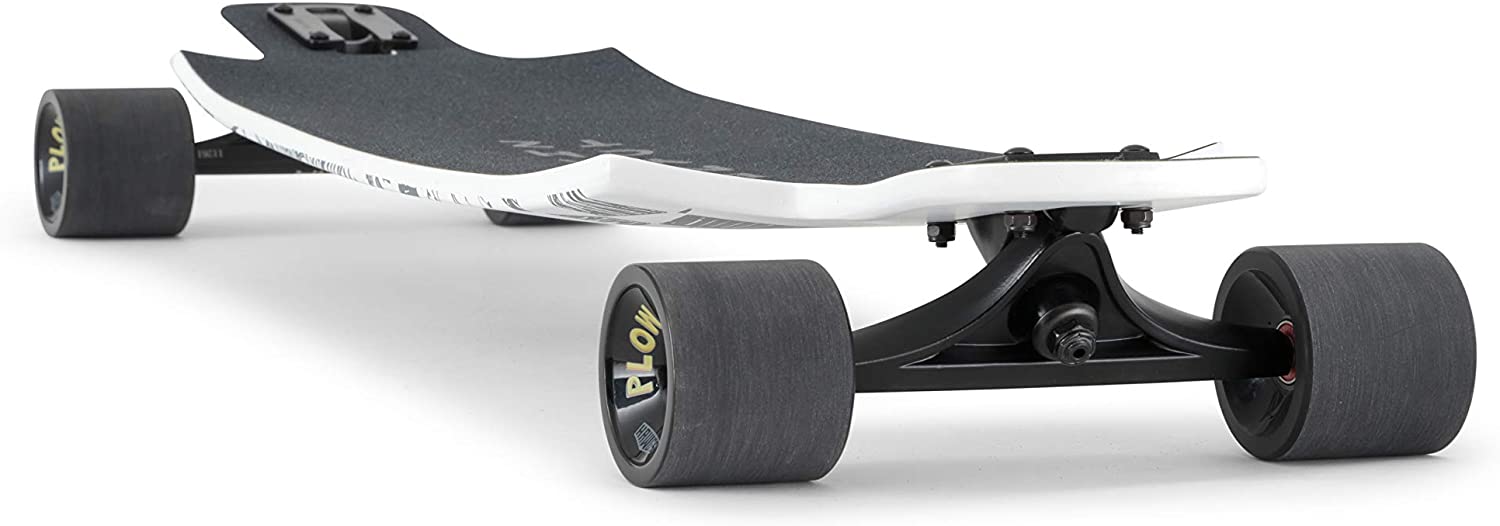
This lowers your c of g and reduces your input over your trucks. It allows for a more stable ride. However, you don’t have a lot of leverage over your trucks and as such it doesn’t feel great to slide with. You can’t push down/on top of the wheels so they sometimes chatter when slid. This is a great option for cruising but not for downhill and learning in my opinion.
It also allows you to try out the top mounting option and switch between the two. You just have to take apart your trucks and mount it either way.
The top mount longboard
The top mount is basically when the trucks are mounted underneath the deck and the standing platform is more or less the same height throughout the board.
Top mount are a racers favorite. It allows you to maximize your leverage over your trucks and wheels. In racing, this is important as you can take the best line and have the best slowing down power and control over your trucks … however, we are not racing just yet.
As far as it goes beginners, the top mount is the least friendly shape.
Because of the leverage and direct input you have over your trucks, the top mount can be quite unstable. It is also very unforgiving and it is easy to get thrown off your board during slides or get wheel bite when carving hard. However, you can set up your trucks to be stable and to allow sliding to be a lot easier and forgiving for you.
I recommend this shapes for intermediates who want to push their ability and for people interested in racing. I do not wholeheartedly recommend it for beginners because it has a steeper learning curve. However, most do get used to it with time and are able to make the most of it.
Other uses: Great for pumping, cruising, slalom
Boards that mix both top and drop mounting – best of both worlds
Manufacturers have realized how useful the drop mounting shape can be and have incorporated it on some top mount decks in different ways. They make decks that have slightly lowered sections. These decks are said to have a ‘drop’ or rocker.
Rocker is when the deck gently slopes lower, and drop is when there is a sudden change in height.
This drop could be just a smidge (like an 8th of an inch) or more. Surprisingly these small drops make a difference. They make the board noticeably more stable and easier to slide. Rocker can have the same effect too.
A famous deck that has rocker is the Loaded Tesseract. if you look at the picture below, you can see that the middle of the deck sits lower than the tail and head. It might not seem like much, but that little change in height makes this board very stable. When riding it, I noticed how much smoother the ride was than my pure top mount board.
If you can’t (or don’t want to) get a dropped board, a board with just a smidge of drop or rocker would do too.
I would say that such boards are best of all-around learning and would be useable for years to come, whilst you might quickly outgrow a pure drop-down deck. They would be what I recommend a beginner to go with.
A downhill longboard should be stiff
Stiffness is an important feature for a downhill skateboard to have. It gives you accurate input and control over your trucks. It also allows you to get accurate feedback on what your trucks and wheels are doing.
At high speeds, this is especially important. Having direct control over your trucks helps you stay balanced and stable.
On the flip side, if you have a flexy deck you’ll find it won’t perform adequately. Your input into the trucks will be dampened by the flex and you won’t have accurate control and feedback. This could lead wobbles at higher speeds as it will allow your trucks to kinda do their own thing and misbehave.
Along with a poorly setup longboard and stance, my man in the video below had a very flexy board (you can see how it flexes under his weight when he steps on it). He did manage to hang on for quite a while which is impressive in its own way hehe.
How do they make boards stiff?
Stiffness is usually achieved by using 8-9plys of wood to make the skateboard. The wood used is often Canadian Hard Rock maple, but Birch and Bamboo are used too.
Board manufacturers can also use composites, like carbon fiber, fiberglass, and even metals in some cases to make the boards stiff. These boards made with composites tend to be stronger and lighter. Vertical lamination is also used to produce a stiff deck.
For example, the Loaded Tesseract in the picture has been made with bamboo, fiberglass and cork. There is even a carbon version available if riders want something stiffer.
When a deck has been designed with a stiffness intended for downhill, it is often called ‘speed stiff’.
As you can see, there isn’t just one way to make a skateboard stiff. So be careful when picking your board and make sure you read its product description to ensure that it is ‘speed stiff’ and has been made with the relevant materials.
GMR skateboards famously use a metal spine for increased stiffness and rigidity. This allows for no flexing along the centre line of the longboard. Their boards are used by racers all around the world. I really want one …
Sanctum collective also uniquely used a sheet of metal aluminum for rigidity and strength. This made their boards both rigid, but also heavy. Descent longboards was born from Sanctum and they now use carbon, vertical lamination and other composites to manufacture their decks.
Does the shape (or cut) matter much?
The shape of a longboard is simply how it has been cut out. The shape of the board doesn’t matter so much and you don’t need to worry about this initially. However, if you would like a more versatile board that you can do tricks on, you should consider getting one with a kicktail or two.
What you do need to worry about, is getting a board that is the right size. You need to look at the width and length of it and you should aim to get one that matches the width of the trucks you have. Also, don’t pick one that is too narrow, I talk about why this is important below.
The size of the deck matters most
The size of the deck matters because it will determine what trucks you get and this will in-turn determine how stable and easy to use your setup will be, and how comfortable and forgiving slides will feel.
Don’t choose a deck that is too narrow
For beginners, I recommend you stay away from decks that are less than 9.5 inches.
This is because you will have to use narrower trucks with a narrow deck. This could lead to a harsher, unforgiving downhill skate experience.
Narrower trucks have a more distinct feeling between gripping and sliding, and they don’t break traction easily. They are also prone to making the rider high-side and fall over. In short, they aren’t very easy to control and can even give you wobbles at high speeds.
Wider trucks are more forgiving. They break into slides easier and don’t need as much rider input to be stable. I highly recommend them for beginners.
In summary, pick a deck that is 9.5inches or wider for a more beginner-friendly experience. Don’t forget to choose a truck that is an appropriate width.
Why should your truck match width with the deck?
It’s important the deck matches the trucks so you can have the best control over them. If your deck doesn’t match with the trucks this is what may happen:
- If the deck is much wider than the trucks – it will feel tippy and hard to balance on. You might get wobbles with it at speed.
- If the deck is narrower than your trucks – it will feel more stable and it might feel easy to do slides with it. But you won’t have the best control over your trucks and it will have very sluggish, off-putting turning.
For example, the trucks in the pictures below are too wide for the deck (and wheel combination). It is not so clear as the picture doesn’t accurately illustrate it. However, you will notice the wheel sticking out on the sides. You typically don’t want your wheels to stick out at all, or too much.
When your trucks match your deck it is called rail matching. The following truck and deck sizes tend to match well together:
- If you have a 10inch deck, go for 180mm trucks.
- For a 9.5inch deck go for 165mm trucks.
- Get 140mm trucks for a 9inch deck.
I have mentioned a 9inch deck here for the sake of providing rail matching information. However, it is not a good choice for beginners to pick as I highlighted earlier.
What length of board should you pick?
The length of the board doesn’t really matter per se … and the length will vary if you choose to get a kicktail or if you choose a drop-down deck or a drop through. The most important thing when it comes to length is primarily the wheelbase.
What wheelbase options should you go for?
The wheelbase is the distance between the mounting holes on your deck. Check out the photo below for a good example of this. It can also be measured as the distance between the axles of your trucks. Today, I will be primarily using the deck mounting holes to describe the wheelbase (this is to make for easy understanding).
A long wheelbase?
In general, a long wheelbase option is great for beginners. I recommend a wheelbase between 25inches and 27inches.
A long wheelbase will be more stable at higher speeds. This is because the setup will have a longer turning circle and will turn and twitch less at those high speeds. (Basically, wobbles come from trucks that are too turny).
In the slides, it will be more controllable and you can get away with making mistakes. They really allow you to get those less than 90 degree slides down so you won’t flat spot your wheels.
However, you will have to setup carve more for the slides if you have a long wheelbase. But when paired with symmetrical trucks, this shouldn’t be a problem.
What about a short wheelbase?
If you’re familiar with longboard racing, you’ll notice that a lot of the top riders are riding boards with wheelbases between 22 to 24inches. This because small wheelbases bring the wheels closer together and directly under your feet. This means you can get better control when riding, and maximise pushing into them when sliding for the best braking.
They also pair the decks with specialized split (assymetrical) degree trucks with narrow hangers. It wouldn’t work the same with symmetrical trucks.
Short wheelbases are not a good idea for beginners. They are twitchy and give you too much control of your trucks. You’ll have a bad time skating it if you’re inexperienced. I recommend you avoid them for now.
In summary, beginners should stick with longer wheelbases. However, I do recommend you experiment with both short and wheelbases to see what you like – especially if your longboard has multiple options that will allow you to experiment. It can be very rewarding to find a wheelbase that matches your style and lets you ride comfortably.
What else should I think about?
- Concave – The concave of a board is basically its cross-section. Some concave are steep and it’s like stepping in a bowl (an exaggeration to illustrate the point). Others are like just stepping on something flat.
As a beginner, you won’t know much about concave, so it isn’t too important to think about right now. But with time and experience, you’ll learn what you like and will be able to pick accordingly. - Griptape – I recommend you get coarse griptape. Coarse grip sticks you to the board and stops you from slipping off your deck when you are sliding. Griptape such as Seismic grip and the more affordable Vicious grip are great options. You can check their pricing on Amazon by clicking the links.
- Footstop – This helps lock your front foot in. There are different types available in different shapes in sizes. They are particularly useful for stand up toeside slides or hand down toeside slides as they really lock that front foot into the board. Check out the Rayne Footstop on Amazon.com.
Great beginner decks – My recommendations
My riding experience is limited to a handful of decks – some of which I’ve recommended below. However, I reached out to the more experienced longboard community for their thoughts on easy to ride decks. You can check out the conversation here on the #WhatGearShouldIBuy group if you want to see who suggested what.
Landyachtz Switchblade – decent all-around choice
The Landyachtz switch-blade is a classic longboard. It’s a staple in the Landyachtz line up and has been around since forever. The Switchblade comes with both drop-through mounting and a drop-down. This makes it a “double-drop” deck. This double-drop makes it easy to skate, easy to slide and keeps it stable at higher speeds.

I’m not a fan of drop throughs. However, you can always mount this as a top mount and skate it that way – it’s a good idea to experiment with it this way.
As a complete, it is fairly affordable. It comes with 180mm Bear Gen 6 trucks, with white 70mm zombie hangs. It also has black course griptape and Bear Spaceball bearings. All these components are high-quality, making the Switchblade a great investment.
If you’re looking for a board to learn to skate downhill with, the Switchblade is definitely a good choice. Check it out here on Amazon.com.
Buy the Switchblade here at the Landyachtz website. Use the code – “AroniSkate&Explore15” for 5% off.
Pantheon CHiller
The favourite of the r/longboarding sub, the CHiller is a longboard designed by Chase Hiller. If you don’t know Chase, he is arguably the best hands downhill and stand up longboarder right now. He won both Devils Peak and Knk No Paws down in the same year. Something I don’t think we’ll ever see repeated.

The CHiller is primarily a topmount, but it has a considerable amount of drop. The standing platform is lower than where the trucks are mounted and this does two things; it makes for a stable ride and also makes the deck easy to slide.
Paired with the W feature and an aggressive but ergonomic concave. the Chiller ensures you know where your feet are on deck at all times.

Specification wise, the Chiller comes in at a length of 36.3inches with a width of 9.6inches. It has a healthy 24.25-26.25inch wheelbase. This makes
At $160, it is quite affordable given its construction, materials, and manufacturing process. To learn more about it, check it out on Muirskate or on the Pantheon website.
Altogether, the Chiller is a great board. However, some riders have said that the concave can feel uncomfortable and a bit boaty. They also said it didn’t let them push on the rail much – which is an issue of riding style really. As a beginner, you don’t need to worry about this yet especially if you don’t have a riding style yet – just keep it in mind if the deck isn’t working for you.
Landyachtz Evo – Great for speed
All hail the Landyachtz Evo. This board has won a lot of races over the years and was the most dominant, race-winning board between 2005 – 2012.
It was so dominant because it was so easy to ride. Gear back then wasn’t the most precise or easy to ride well, so having a great deck that was stable at speed and slid easy was key to a lot of victories.
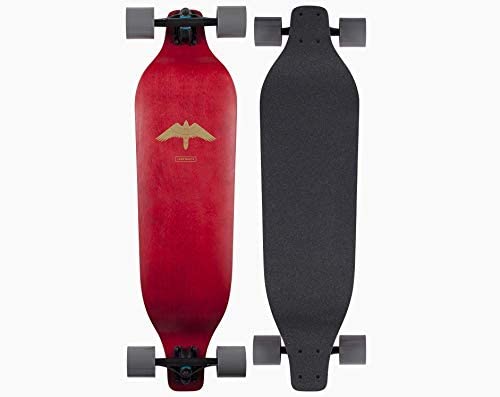
The Evo is pretty unique. It features a large drop-down to the standing platform and has the trucks mounted at an angle. With the back and front being a -15* and +15* anlges respectively.
So if you mount a 45* truck on the Evo, you’ll end up with angles of 60* in front and 30* in the back. This will make for a stable ride and will make high speeds feel more comfortable. So if you’re looking for a board you can easily hit high speeds with, the Evo is a good choice.

The board is 36 in long and 9.5inches wide. It’s made from Canadian maple. It comes with Bear trucks, Spaceball bearings and 76mm Hawgs wheels. You can find out more about it here on Amazon.com.
You can buy the Landyachtz Evo here at the Stokedride shop.
You can also buy the Evo here at the Landyachtz website. Use the code – “AroniSkate&Explore15” for 5% off.
This board is great for beginners, especially if you want to go fast. However, it isn’t very good for learning slides and improving your technique. The grippy wheels from the complete won’t slide easy and the different truck angles won’t let it break traction easily. If you just want to go fast, it’s not a bad choice. Not the best for progression though.
Prism Theory V2
Coming in at 36inches in length and 10inches in width, the Prism Theory is one of the best beginner downhill skateboards. It has a fairly simple construction and is made with 7plys of maple and 2 sheets of Fiberglass. This keeps it stiff, strong but allows it to be lightweight. Finally, it features micro drops, rocker and has big wheel flares.
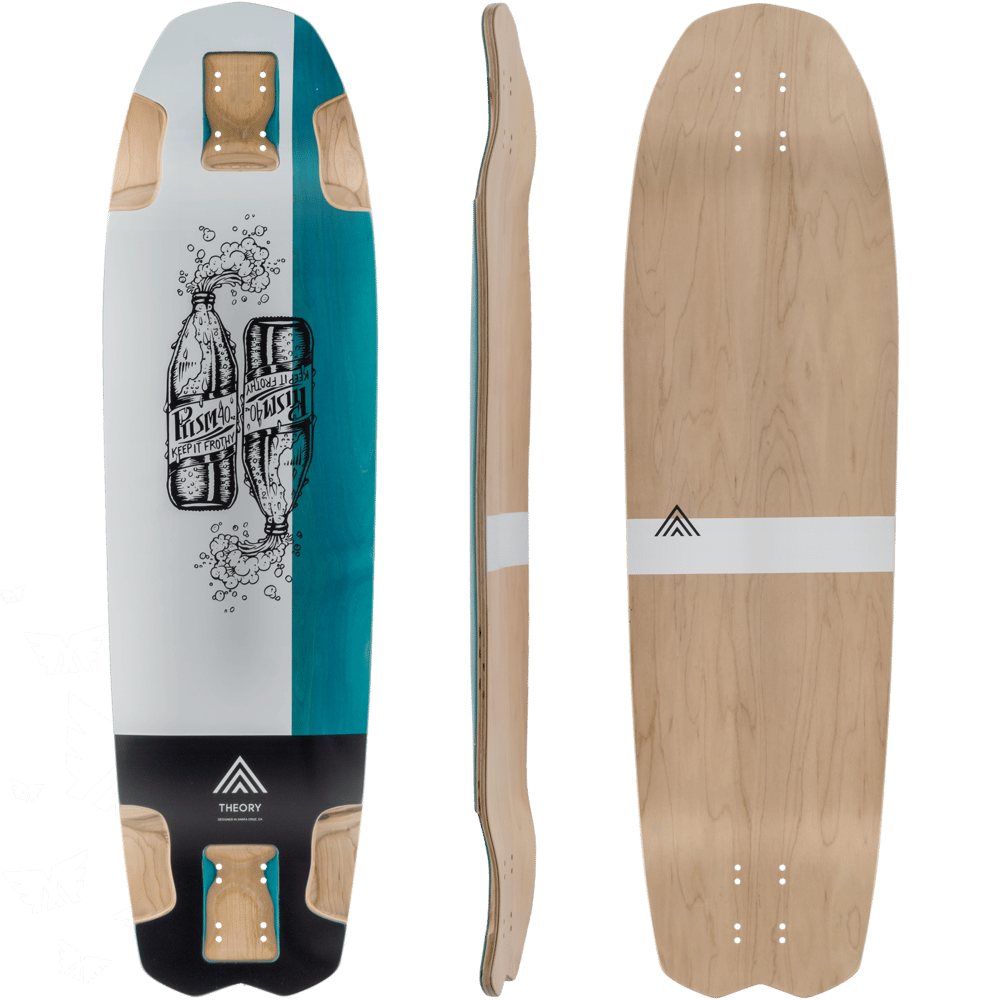
The micro drops, wheel flares, and rocker make the board look like it has a considerably lowered platform. However, it isn’t so. The board isn’t as low as it looks. That said, it still has rocker so the standing platform is lower.
The micro drops and wheel flares give you something to wedge your feet into for slides. It also has W, which helps keep your feet in place. And despite having all these features, the board never feels uncomfortable or like it gets too much in your way. It feels comfortable and natural.
Finally, unlike the Tesseract below, the Theory has flush mounts (basically, cutouts where the trucks), so that the rockered profile doesn’t wedge the trucks.
Out of all the options on my list, this might be the best choice. It isn’t too expensive and features all the characteristics of a good beginner board. It also seems like it would work well for a lot of different riding styles. I think it is worth considering and checking out. Check out the Theory V2 here at Amazon.com.
Loaded Tesseract
The Loaded Tesseract is one of the best all-around downhill boards on the market. It comes with a high-quality construction and in a versatile shape. The Tesseract is vertically laminated, using bamboo, fiberglass, and cork in its construction. It comes with ergonomic concave, featuring W, wheel flares and rocker.
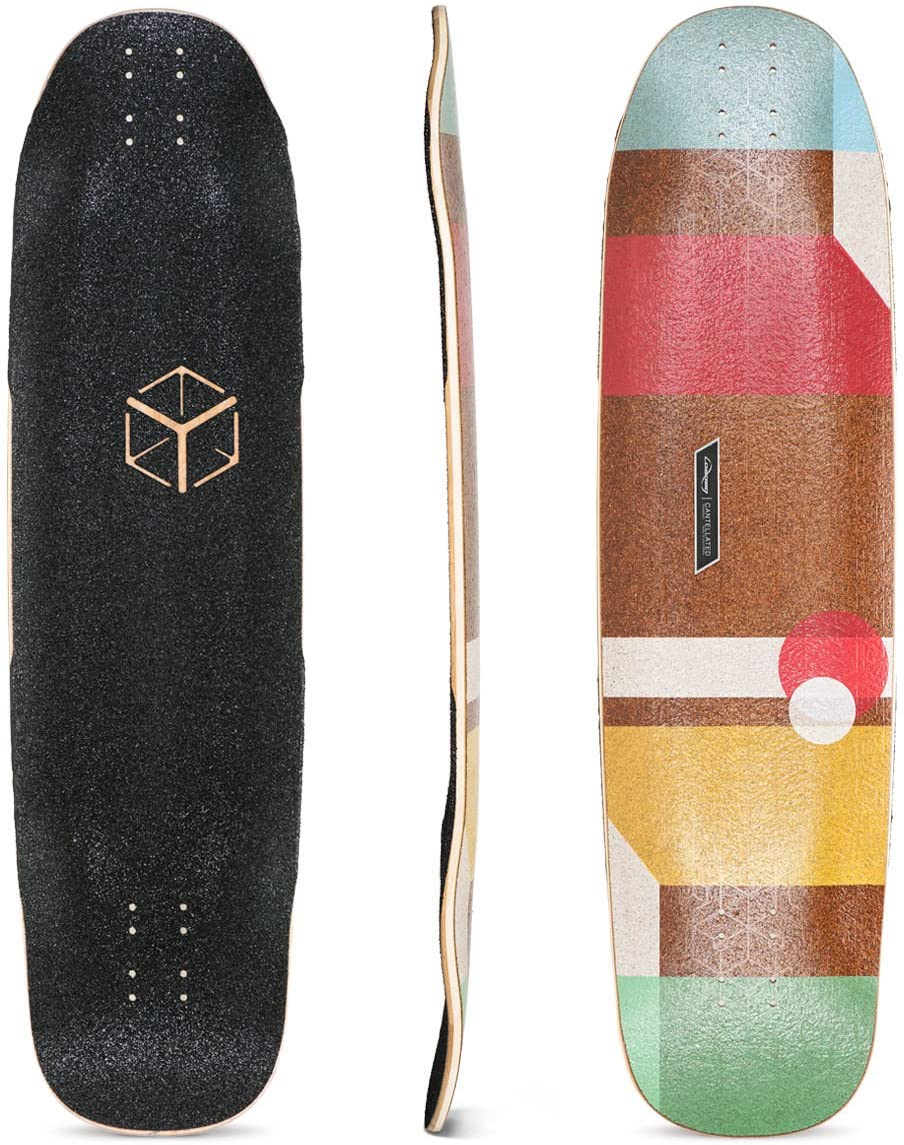
The Tessy has a rockered platform that sits lower in the middle than it does at the mounting points. This allows the Tessy to lower your centre of gravity which makes for a stable ride and makes slides easier. However, this rockered profile forces the mounting points to be wedged 3*. Even with this wedging, the Tessy remains very stable. It just increases the turning a little bit more.
Finally, the Tessy comes in 3 shapes. The Cantellated Tessy comes with a kicktail. The Truncated Tesseract has no kicktail. Both have widths of 9.5inches and wheelbase between 24.5 to 26inches. They have different lengths.
In a review I wrote, I said the Tesseract isn’t a very good beginner deck because the W can restrict and interfere with your riding/learning experience. Check out the review here. I still agree with that statement, but I’ve also come to believe that you can learn to skate and adapt to it. I believe the Tesseract is a board you grow into, rather than it instantly fitting your riding style.
All in all, the Tesseract is one of the best decks I’ve had the pleasure of skating. It’s a deck that will enhance your skate experience and that will last you a long time too. Though it is quite expensive, I think it is well worth the investment. Check it out here on Amazon.com.
Others good beginner boards:
- Subsonic Talon
- Muirskate Muiderer – very affordable top mount
- Rayne Vandal
- Prism Reaver
- Alkemist Ghost knight
- Eastside relic – very affordable
- Pantheon Gaia
- Zenit Marble – semi affordable
- Omen Chief
- Madrid Dominant – Dubler pro – affordable
- Moonshine Pro tucker
- Original Arbiter KT
- Luca Longboards Orion
Decks you should avoid for downhill as a beginner
The following boards aren’t inherently bad. They’re simply not good for beginners as they don’t offer a very forgiving ride. You’ll still be able to ride and slide with them, but you won’t necessarily have the best experience.
Descent Big Red 30in
This deck comes in at a very small 30inch in length with a narrow 9inch width. It’s been designed for racing and around trucks that are between 110mm to 140mm in size. It is a pure top mount and features narrow wheelbase options between 20 and 24inches.
The Big Red is vertically laminated using composites. It has a top and bottom carbon sheet and uses urethane bumpers on the head and tail. Finally, it retails at about $250.
This deck isn’t inherently bad. In fact, you’ll see it being used a lot on the race circuit. The high-quality construction, concave and lightweight nature of this board makes it highly desirable. It also allows racers to run big wheels, small wheelbases and to pair it with narrow trucks.
However, it isn’t a good option for a beginner. It is too expensive and is designed around gear that is rather inaccessible and inappropriate for most beginners to learn with. It isn’t a good place for a beginner to start if they want to learn.
Madrid Lead Foot – Zak Maytum pro model
Designed by the legend Zak Maytum, this is a slalom style board built of downhill racing. It comes in a small 32inch length with a width of 8.875inches. It has wheelbases between 22.5inches and 23.75inches.
This board was designed to be used with Slalom trucks and huge downhill wheels. Like the Descent Big Red above, it is also inappropriate for beginners. However, it is quite affordable, so would be a good choice if you want a small board for grip runs and running small trucks.
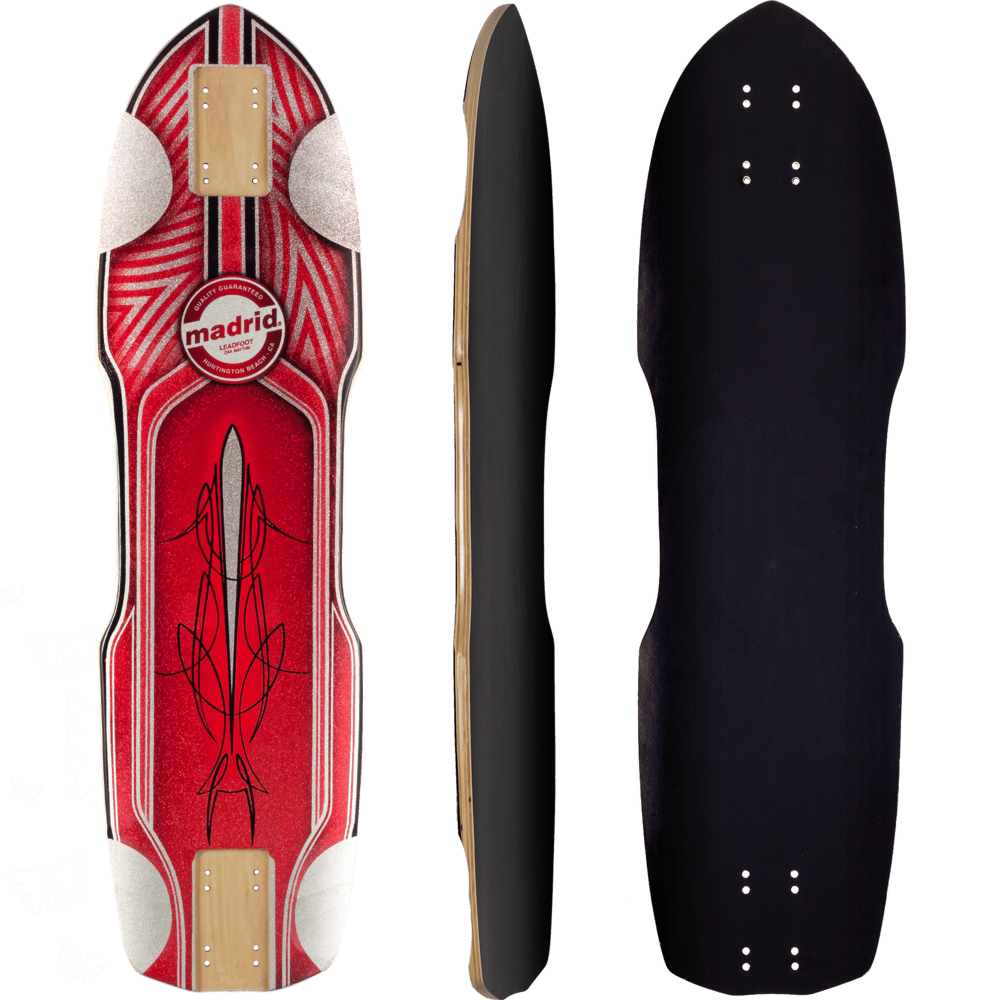
Landyachtz Small Blind
Just to drive the point home, such a deck will be bad for a beginner. It’s (once again), built around small trucks and big wheels for racing. It’s been designed so riders can grip corners and so that making your wheels slide out is as difficult as possible. Finally, the small wheelbase makes it very unstable, unless it is paired with slalom trucks, or with split degree trucks with a very low angle in the back. Beginners should avoid it.

Loaded Icarus
The Loaded Icarus is a drop-through board. It comes in at 38inches in length with a 8.4inch wheelbase. It has drop-through mounting and comes stock with 50* Paris trucks, 80a Kegels and fine griptape. The deck itself is very flexible and features a cambered profile.
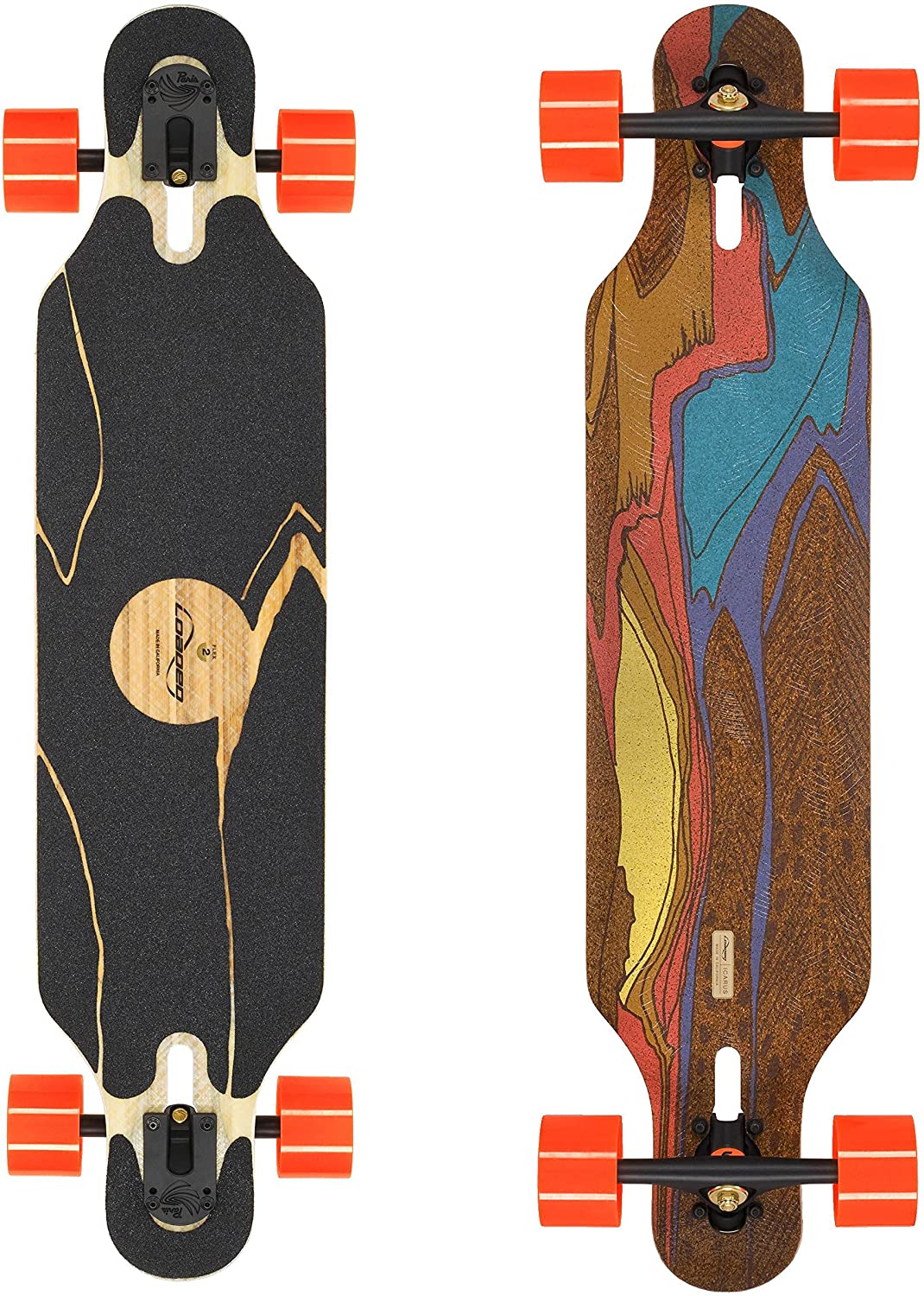
The board will work excellently as cruiser. The flex will provide a comfortable ride that will cushion any vibration from rolling. The drop-through mounting will lower your center of gravity and allow pushing and foot breaking to be easier. Finally, the 50* Paris trucks will allow for a quick turning, responsive ride. However, these features that make it great for cruising make it absolutely awful for downhill.
At high-speeds, the flex from this board will give you awful control of your board. The 50* trucks will also be very twitchy and unstable. The cambered profile won’t lock you into the deck and the fine griptape will make it easy for you to slip off. Such a board will be prone to wobbles – and I’m sure it has claimed many a victim who thought they could take it downhill. Avoid such a board for downhill.
Santa Cruz Pintail
At 39inch in length and 9.58inches in width, this Santa Cruz cruiser is huge. It comes in the classic pintail shape, which is thicker in the middle and tapers towards the ends. This shape offers no performance advantages whatsoever – in fact, it reduces the board width over the trucks, limiting how much leverage you have and ultimately how much control you have.
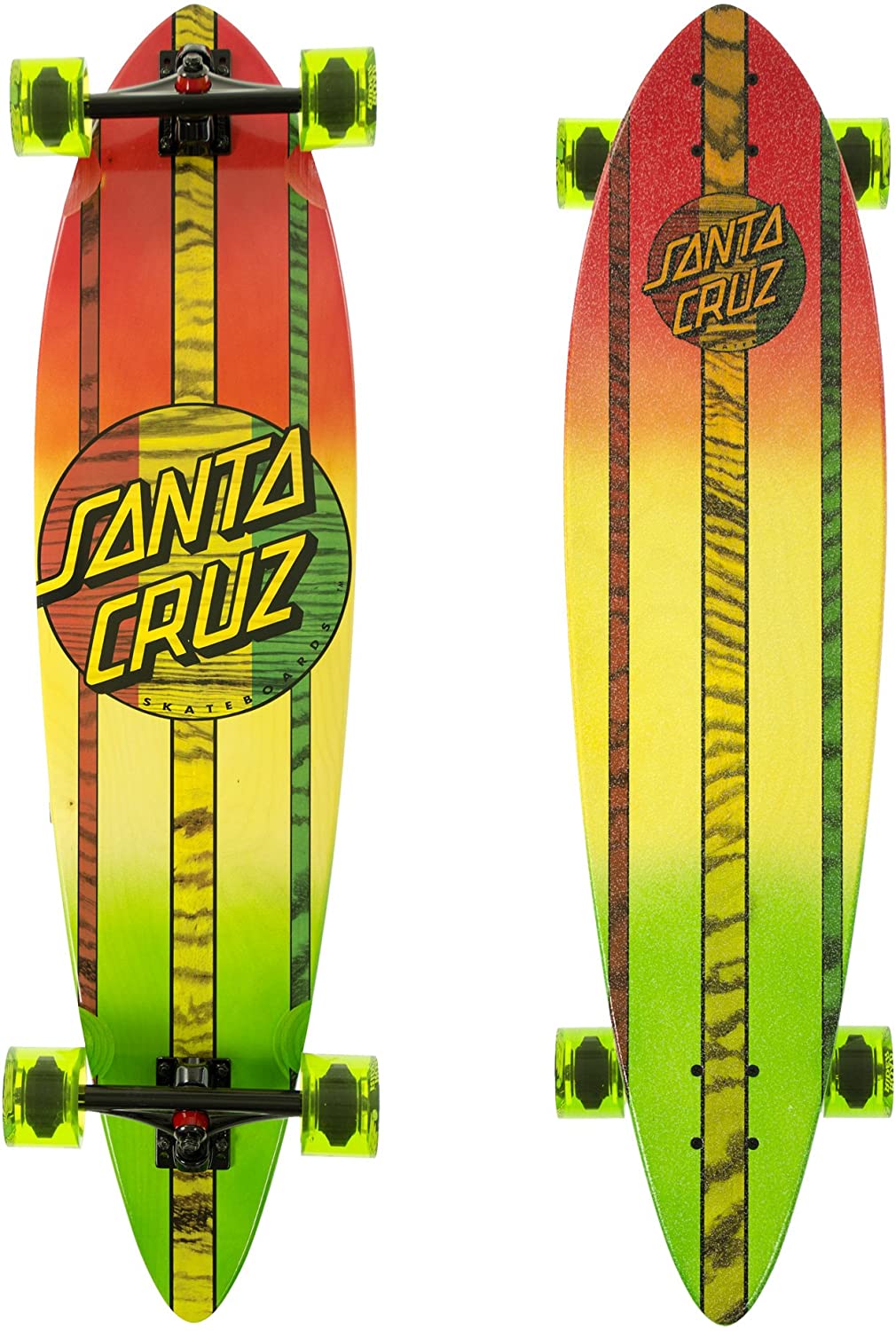
The shape does look nice though, so it does have its use. The complete itself isn’t that impressive. It comes with Bullet trucks and 90a OJ wheels. The deck is made from 7plys of maple and has little flex. The Bullet trucks have cone bushings which make this board quick turning and responsive. These features make it a little bit decent for cruising.
However, like the Icarus above, the same features make it awful for downhill and skate at speed. I can guarantee that this board will give 99% of riders wobbles past 20mph. If you want to avoid unnecessary road rash, don’t pick up such a board for skating down hills.
Sector 9 Aperture
Though marketed as a downhill board – check out the product description for yourself here on Amazon.com. This board is not good for that. In fact, take it anywhere over 15mp and you’ll probably start to get wobbles. This is because this board was built for cruising, pumping and to be quick turning. It was built so it has a responsive ride at slow speeds.

When a board is designed to feel good for slow speeds, it is almost guaranteed that it will be awful for faster speeds. The Aperture is good example of this. The Sidewinder trucks are so turny to the point they feel floppy with no center point – this is nice as you can make tight curves, but will give you wobbles at faster speeds. The deck is flexy which gives you no control over your trucks when you go fast and can even bounce you off the deck on rough terrain.
Just … avoid such boards. They won’t give you a good downhill experience at all. If anything, they may just send you to the hospital for road rash, a fracture or a concussion. If you buy them with the intention to skate downhills, you’re simply wasting your money.
Anything cheap, from a less reputable brand:
Brands like Magneto, Atom, Quest, Volador, Yocaher, Volador, White Wave, Minority etc. Basically most cheap Amazon brands. These guys will have boards they advertise as built for downhill or speed. The truth is, most of these boards are subpar and won’t be good for downhill. They might have good designs or look good, but the construction and concave won’t be right.
For example, the Atom Downhill board.
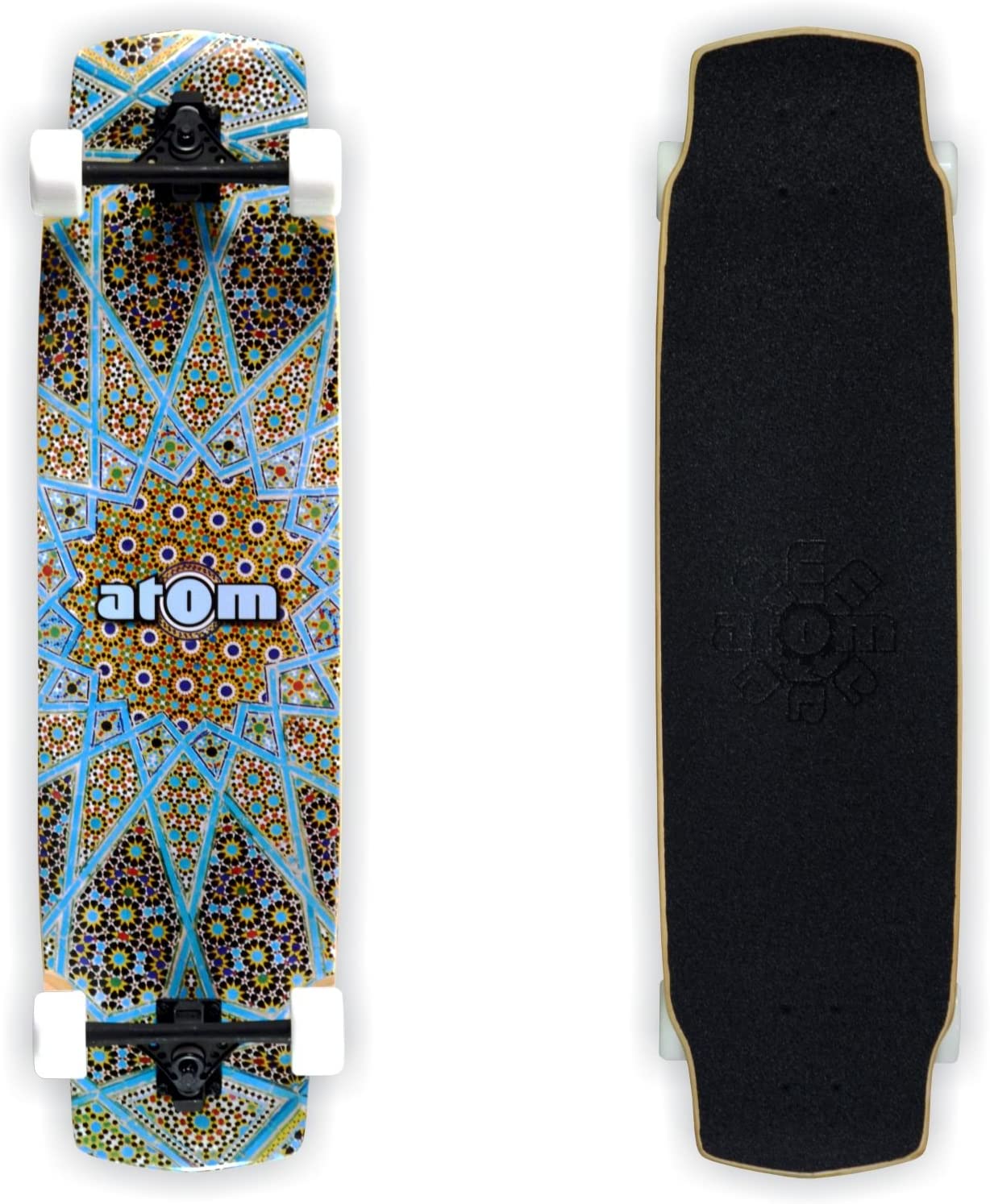
I’m not gonna lie, it does look cool and the graphic looks great. However, when you look at the components you get disappointed. The trucks are knockoffs (of Atlas trucks, which aren’t that good) and use cheap bushings and pivots. They also don’t turn smoothly and have a choppy ride. The wheels come from a no-name brand., and whilst they are cut as slide wheels, their slide probably isn’t that smooth.
Such boards won’t be reliable for downhill at all. They won’t be stable at speed or be easy to learns slides with. It’s better you try and avoid them altogether. As a rule of thumb, if there are no videos of riders doing actually slides on them, or no reputable longboard recommends them, then stay away!
Which longboard is right for you?
The most important factor for longboarding is experience and figuring out what you like. You do that by buying a board, riding it and using the feedback to influence your future purchasing decisions. That said, there are some general features that make one board easier to ride than another.
I hope my article has been useful! You don’t have to pick any of the boards on my list but please use my article to guide you on whatever you do choose. If you have any questions, feel free to message me on my social media accounts and I’ll happily answer.
If you are having trouble deciding on a board, I recommend either the Loaded Tessy or the Prism Theory. If you can test ride the CHiller before buying it, it could be a good choice too.
If you like this article and want to read more, let me know on social media! Getting feedback from people is how I know these articles are helping people. Alternatively, you can also support me through Patreon. Whichever works for you
Thanks to Patrons Jed, Mowgii, and SuperBadJuJu for the support so far.
Check out other relevant posts here:
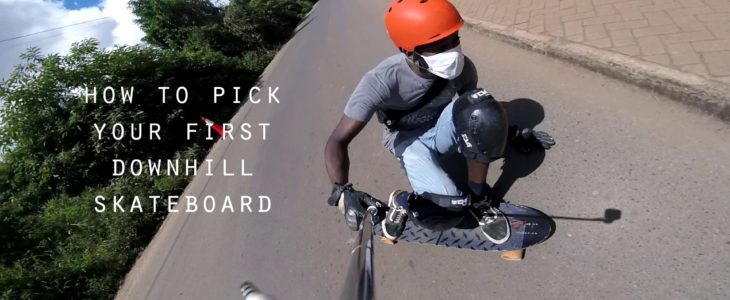
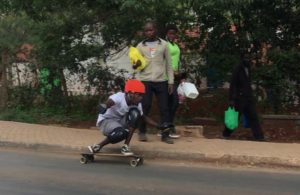
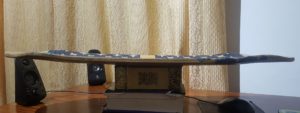
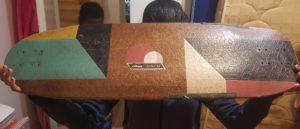
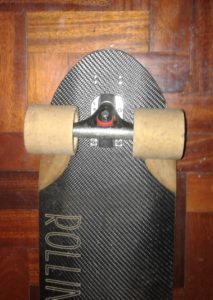
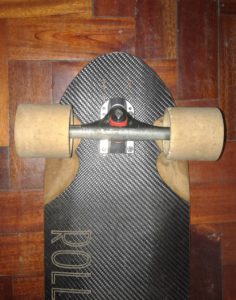


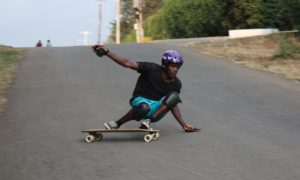
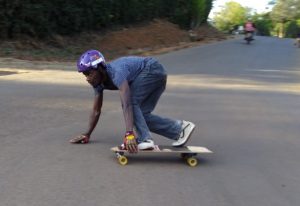

13 comments on “Best downhill longboards for beginners”
Roy
January 17, 2022 at 9:18 amDo have an updated list on beginner boards? I can’t find a lot of the boards listed in this article.
AbugaA
January 21, 2022 at 12:25 amSure. Landyachtz Freedive, Zenit Marble, Cole Trotta Pro, Cheese grater, Madrid Nessie etc.
Vira
April 29, 2022 at 10:46 pmHi.
How about Prism Reaver?
AbugaA
May 1, 2022 at 6:51 pmit’s pretty good!
Vira
May 2, 2022 at 2:23 pmMy first freeride board.
Supercomfy)
Kamil
May 23, 2022 at 1:59 pmHi,
Maybe you had contact with the Alternative Longboards Pro – FUNTAIL?
Do you think it’s good for beginner?
Best regards,
Kamil
AbugaA
June 2, 2022 at 1:10 pmNever skated it, but it looks good!
Marcus
June 15, 2022 at 10:17 amwhat do you think about the Byron Essert Mini Frog?
AbugaA
July 5, 2022 at 3:21 pmgood board, a bit flexy I hear
Bob
August 10, 2022 at 9:01 pmHey,
I was looking at getting Tesseract but loaded have 3 different versions, which one would you recomend?
AbugaA
August 11, 2022 at 2:55 pmthe ones for DH! I think the Cantellated one is the one you want?
Pablo
January 16, 2025 at 11:35 pmI just followed your buying advice and got a prism theory with Paris trucks 45° and already had some snakes around. Holy crap, what have I been doing the last years. I basically made most of the mistakes in terms of gear apart from the wheels.
Started learning to slide on a loaded tan tien, drop through and flexible. Then tried a harder bustin modela but with a really small wheelbase. Eventually tried also Zenit morning wood again small wheelbase. And finally loaded mata hari, long wheelbase but the most flexible of all and not much of griptape… I managed to learn some basic slides and going down in one piece, but this is whole a new game. Many thanks for your detailed advice master Abuga.
AbugaA
January 23, 2025 at 1:34 pmHehe, glad to finally get you on the right path mayne. Enjoy, eager to see your progress